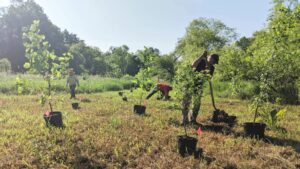By Anna Willig and Lauren McGrath | Willistown Conservation Trust Watershed Protection Program
Cover Photo by Jennifer Mathes
Since 2018, the Watershed Protection Program has monitored water quality at ten sample sites in the headwaters of Darby, Crum, and Ridley Creeks (Map 1). Every four weeks, the team visited each of the ten sites to take in-stream measurements and collect samples for analysis in the lab. We are proud to present our findings on water quality based on analysis of our data collected from 2018 through 2021, which includes 41 monitoring visits and over 7500 different measurements.
August is National Water Quality month, and each week we will publish excerpts from one chapter from our report. Last week, Chapter 3 focused on specific conductivity, chlorides, and nutrients. If you missed the introduction to water chemistry, visit Chapter 1, or the primer on physical stream characteristics, see Chapter 2. This week, we are focusing on alkalinity and hardness. The full report, which includes more information than is provided in the blog posts, can be found here.
Two final parameters that enhance our understanding of water quality are alkalinity and hardness. Alkalinity measures the ability of water to neutralize acidic compounds and resist changes in pH. Higher alkalinity indicates a greater ability to resist pH changes from pollutants such as wastewater effluent, protecting stream life from acidic or basic environments. Hardness is the concentration of calcium and magnesium ions in the water. Hard water has high concentrations of these ions and is generally more of a nuisance than a health concern for humans or stream life. When water is hard, it can leave behind residue on pipes, potentially leading to lower water pressure or clogging.
Alkalinity and hardness both remain within acceptable levels for waterways in this region. Alkalinity and hardness are significantly higher in Darby Creek than in Crum and Ridley Creeks. This is most likely due to differences in regional geology, as alkalinity and hardness are primarily affected by the types of rocks and soils that water flows through. However, weathering of man-made materials, particularly concrete, can alter these parameters, and any sudden changes should be investigated.
For a primer on statistical tests and how to read boxplots and scatterplots, click here.
Alkalinity
Figure 1. Alkalinity from January 2018 through December 2021 (a) across ten sample sites in the headwaters of the Darby, Crum, and Ridley Creeks and (b) over time.
Alkalinity, analyzed quarterly, measures the ability of a body of water to resist changes in pH; higher alkalinity denotes a greater ability to resist pH changes.1 Local geology tends to be the primary driver of alkalinity, though accelerated weathering of natural materials and weathering of man-made materials, namely concrete, increases alkalinity.2 Alkalinity remains above the Pennsylvania Department of Environmental Protection minimum of 20.0 mg/L at all sites.3
There are significant differences in alkalinity between sites. Alkalinity is significantly higher at Darby Creek at Waterloo Mills (DCWM1) than at all other sites (Figure 1a). Alkalinity does not vary significantly with Crum Creek, but within Ridley Creek, alkalinity is significantly lower at West Branch Ridley Creek (WBRC1) than at Ridley Creek at Okehocking Preserve (RCOK1) (Figure 1a).
Hardness
Figure 2. Hardness from January 2018 through March 2021 (a) across ten sample sites in the headwaters of the Darby, Crum, and Ridley Creeks and (b) over time.
Hardness, analyzed quarterly, is the concentration of dissolved calcium and magnesium ions in water.4 Hardness is primarily governed by the geology of a region; water dissolves calcium and magnesium as it flows through rocks and soils. Based on standards from the United States Geological Survey, water in Crum Creek is moderately hard, water in Ridley Creek ranges from moderately hard to hard, and water in Darby Creek is hard.4
There are significant differences in hardness between sites. Hardness is significantly higher at DCWM1 than at all sites besides WBRC1 (Figure 2a). Hardness varies significantly within Ridley Creek but not within Crum Creek (Figure 2a). There is little seasonal variation in hardness (Figure 2b).
Key Takeaways
- Alkalinity is high enough at all sample sites to protect stream life from rapid changes in pH.
- Water ranges from moderately hard to hard within the sample area. This does not pose any risk to stream life.
- Differences in alkalinity and hardness between sites are likely due to differences in regional geology. No actions are needed to alter alkalinity and hardness.
To read the full “State of our Streams Report,” click here.
Map 1. Willistown Conservation Trust’s sampling sites. Five sample locations are within the Ridley Creek watershed, four are within the Crum Creek Watershed, and one is within the Darby Creek Watershed. Sampling was conducted at each site every four weeks from January 2018 through December 2021.
Funding
This report was made possible through a grant from the William Penn Foundation. The WIlliam Penn Foundation, founded in 1945 by Otto and Phoebe Haas, is dedicated to improving the quality of life in the Greater Philadelphia region through efforts that increase educational opportunities for children from low-income families, ensure a sustainable environment, foster creativity that enhances civic life, and advance philanthropy in the Philadelphia region. In 2021, the Foundation will grant more than $117 million to support vital efforts in the region.
The opinions expressed in this report are those of the author(s) and do not necessarily reflect the views of the William Penn Foundation.
References
1. United States Geological Survey. Alkalinity and Water. Water Science School https://www.usgs.gov/special-topic/water-science-school/science/alkalinity-and-water?qt-science_center_objects=0#qt-science_center_objects (2018).
2. Kaushal, S. S. et al. Human-accelerated weathering increases salinization, major ions, and alkalinization in fresh water across land use. Appl. Geochem. 83, 121–135 (2017).
3. Pennsylvania Department of Environmental Protection. 25 Pa. Code Chapter 93. Water Quality Standards § 93.7. Specific Water Quality Criteria. http://www.pacodeandbulletin.gov/Display/pacode?file=/secure/pacode/data/025/chapter93/chap93toc.html&d=reduce (2020).
4. United States Geological Survey. Hardness of Water. Water Science School https://www.usgs.gov/special-topic/water-science-school/science/hardness-water?qt-science_center_objects=0#qt-science_center_objects (2018).
— By Anna Willig and Lauren McGrath | Willistown Conservation Trust Watershed Protection Program





